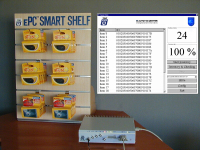Mar 11, 2003March 11, 2003 - Tagsys, a French RFID systems provider, recently demonstrated the use of a 13.56 MHz RFID tag to track products on shelves. The demonstration was done at the Auto-ID Center's recent board meeting and was part of the process of certifying the high-frequency version of the center's Class 1 specification.
Most of the focus has been on the UHF version of the Class 1 spec because it was done first and because end-user sponsors want to begin deploying RFID in warehouses, where UHF is more suitable. But the HF version is progressing through the center's certification process, and Tagsys and Philips Semiconductors showed the tags' capabilities.
Back in November, the two companies showed how a Tagsys flatbed reader could read Philips tags on 50 bottles of Pantene shampoo from Procter & Gamble. This time, Tagsys read Philips tags on rolls of Kodak film on a hanging rack. The tags were read at a rate of 200 per second with 100 percent accuracy. Tagsys also showed how the same multi-protocol Medio L200 RFID reader could write electronic product codes to the tags in the field.
"In order to demonstrate the broadest flexibility of this technology, we felt that a hanging rack demonstration would be ideal," says Alastair McArthur, Tagsys' VP Technology and business development. "We purchased an off-the-shelf retail display and added the RFID capability to make it as much like as real life as we could."
Using Tagsys software, the system was able to continuously read the tags on the rack. "You can look for aberrant patterns to try to deal with a potential theft," says McArthur. "The system can also help retailers understand peak purchasing periods during the day."
Tagsys was spun out of Gemplus, the world's largest smart card maker. Because of its long history with Gemplus, the company has particular expertise in 13.56 MHz RFID systems and a broad international presence.
Some companies are experimenting with smart shelves that use UHF tags and readers. But McArthur firmly believes that 13.56 MHz is the better frequency for smart shelf applications because the reader field is more uniform and the field can be more clearly defined (UHF tags are more likely to bounce of metal and give you false reads).
Tagsys sees a huge opportunity as retailers move toward item-level tagging. It plans to produce 13.56 MHz transponders with EPCs. It will also develop software to enable its fixed and handheld readers to be able to read EPC tags. "We plan to implement EPC across our full range of products," McArthur says. "It's a worldwide frequency and doesn't have the regulatory issues that surround UHF."


